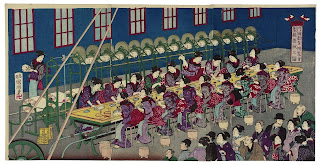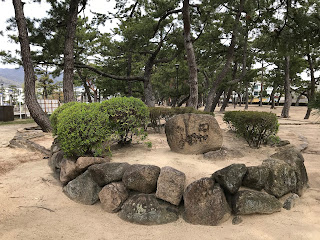Associated with: Nue aka "the Japanese chimera"
While Heian Shrine doesn't have the most romantic of origins, it ties in with our story as a partial reconstruction of the original Heian Palace.
You see, 1894 was the year that the Fourth National Industrial Exhibition was scheduled to be held, but to line it up with Kyoto's 1100 year anniversary, the exhibition was pushed back to 1895. This illustrious event was held in Okazaki Park and hosted several interesting exhibits, such as the art pavilion, the technology pavilion, the machinery pavilion, the agriculture and forestry pavilion, not to mention the fisheries pavilion to name a few. The machinery pavilion was even powered for the first time by electricity instead of coal. Who gives a shit, right?
Well, as part of the exhibition but also as a way to celebrate the 1100 year anniversary, it was decided that the Heian Palace would be rebuilt. An attempt was made to do this on the original site (which would have been pretty awesome) but enough land could not be acquired. In the end it was constructed in the Okazaki Park area at 5/8 the original size. After the exhibition was over, the Heian Palace reconstruction was converted into a shrine honoring Emperor Kanmu, the first emperor of the Heian Capital. Later in 1940, Emperor Komei (r. 1846-1867) was also enshrined, he being the last emperor to reign from start to finish in Kyoto. These days it's pretty hard to imagine Kyoto-ites being insecure about anything, but apparently the people of Kyoto were somewhat disheartened when the capital was moved to Tokyo in 1868. The funding and reconstruction of the old Heian Palace was said to in part be a way of lifting the city's spirits and cheering the population up.
That's nice, but what about the nue? First, you'll recall that the Heian Palace was the one in which Emperor Konoe actually resided at the time of the nue incident; so even though it's a replica, Heian Shrine will give you a feel of Konoe's original surroundings. What's incredible though, is that during construction in order to clear the space for the shrine and exhibition grounds, a nuezuka was excavated and removed! Believe it or not, where some tennis courts are located just south of Heian Shrine used to be another nue mound. It's not known if this was Yorimasa's nue or another of the creatures (there were said to be others), but most accounts of the 1153 nue have it being whisked far away from the capital by one means or another.
As we know from the Osaka account, nue aren't too thrilled about having their graves disturbed, but that's something we'll save for the next entry.
Comments: Heian Shrine will give you a feel of Emperor Konoe's surroundings in 1153. You may be starting to have a problem with reconstructions, but that is a dragon you need to slay pretty quickly to enjoy Japan. If Rashomon and Saiji have taught us anything, it's that things not in use for a 1000 years rarely get rebuilt. That we have a site like Heian Shrine, a revisiting of a historical site not seen in any real form for 600 years, is actually kind of exciting. You can also play tennis while you're there.
Getting There
The starting point on the Midosuji subway line is Yodoyabashi Stn. Our destination is subway Higashiyama Stn. Like our outing to Daishogun Shrine, we're going to first go to Sanjo Stn. on the Keihan Line. Here's a reminder on how to get there:
Subway Yodoyabashi Stn. is one stop south of Umeda. At the north end of subway Yodoyabashi Stn. you'll find the Keihan Line. From Yodoyabashi, the Keihan Main Line runs all the way into Kyoto. To get to Sanjo, you can jump on the fastest service there is: the Limited Express. If your hotel is in the Kyobashi area or anywhere near Osaka Castle Park, then I recommend you make your way to Kyobashi and commence your journey from Kyobashi Stn. (Keihan Line).
From JR Kyoto Stn. you can take the JR Nara line and go one stop to Tofukuji, where there is an adjacent Keihan station. You can also walk from Kyoto Stn. to Shichijo Stn. in about 15 minutes and take the train three stops up from there.
As you come out of the ticket gates at Sanjo Stn., you will find yourself underground. Instead of going straight up to the street level, follow the signs to subway Keihan-Sanjo Stn. and continue underground until you are in that station (near the ticket machines, ticket gates, etc.). To get to Higashiyama Stn., you just need to go one stop from Keihan-Sanjo. However, if you've gone to Daishogun Shrine...
http://yokaitourbus.blogspot.jp/2015/11/vii-daishogun-shrine-aka-live-nue-part-1.html
...you might as well just walk from there. All you need to do is get back on the main drag and walk a bit further.
Getting Your Bearings at Higashiyama Station
Higashiyama is not that big a station. Go out Exit 1 and hang a left on Sanjo Dori (the great big street you come out at). After that, it's not too tricky. Just follow the maps below:
Map courtesy of Google Maps
Map courtesy of Google Maps
Note: Daishogun Shrine is tucked away in the bottom left-hand corner of the first map.
The former nuezuka used to be where the Okazaki Park tennis courts are. They appear on the map above as "Tennis Court" and you should be able to find them easy enough, but I present them to you now combining google's "Earth" view and the magic of MS Paint.
Map courtesy of Google Maps
Heian Jingu Relative to Kyoto Gosho and Other Nue Sites
Several other nue-related sites (at least Kyoto ones) are within just a few miles of each other. On the map below (from left to right) are Nijo Castle, Kyoto Gosho (The Kyoto Imperial Palace), the Kamo River, and Heian Shrine. Not that far to the south are Daishogun Shrine and Shinmei Shrine. We haven't done an article on the Kamo River, but it was recently mentioned in the entry on the nuezuka in Osaka. You'll recall that it's the river from which the nue's carcass was "flushed" out of the capital.
Information on Heian Shrine or Heian Jingu
The shriney bit of Heian Shrine is open every day from 6:00 until 17:30. At certain times of the year it may close half an hour earlier, so aim for a slightly earlier time to be safe. Entrance is free, baby!
The Heian Shrine garden is also open every day, but opens a little later at 8:30. The closing time is 17:00, and like the shrine may close half an hour earlier depending on the season. You need to pay to see the gardens. Many of the rocks in the garden came from the Fushimi Castle ruins.
Driver Gragma (yokaitourbus "at" mail "dot" com)
Facebook: https://www.facebook.com/yokaitourbus/
The Master List (Kyoto)
http://yokaitourbus.blogspot.jp/2015/08/6-c-master-list-kyoto.html
(yokai) Nue (鵺)
Site: Heian Shrine, or Heian Jingu (平安神宮); and the Grave of the Nue, or Nuezuka (鵺塚) in Kyoto
Nearest Station: (subway) Higashiyama Stn. (東山駅)
Google Map Search: "Heian Shrine"
Facebook: https://www.facebook.com/yokaitourbus/
The Master List (Kyoto)
http://yokaitourbus.blogspot.jp/2015/08/6-c-master-list-kyoto.html
(yokai) Nue (鵺)
Site: Heian Shrine, or Heian Jingu (平安神宮); and the Grave of the Nue, or Nuezuka (鵺塚) in Kyoto
Nearest Station: (subway) Higashiyama Stn. (東山駅)
Google Map Search: "Heian Shrine"














